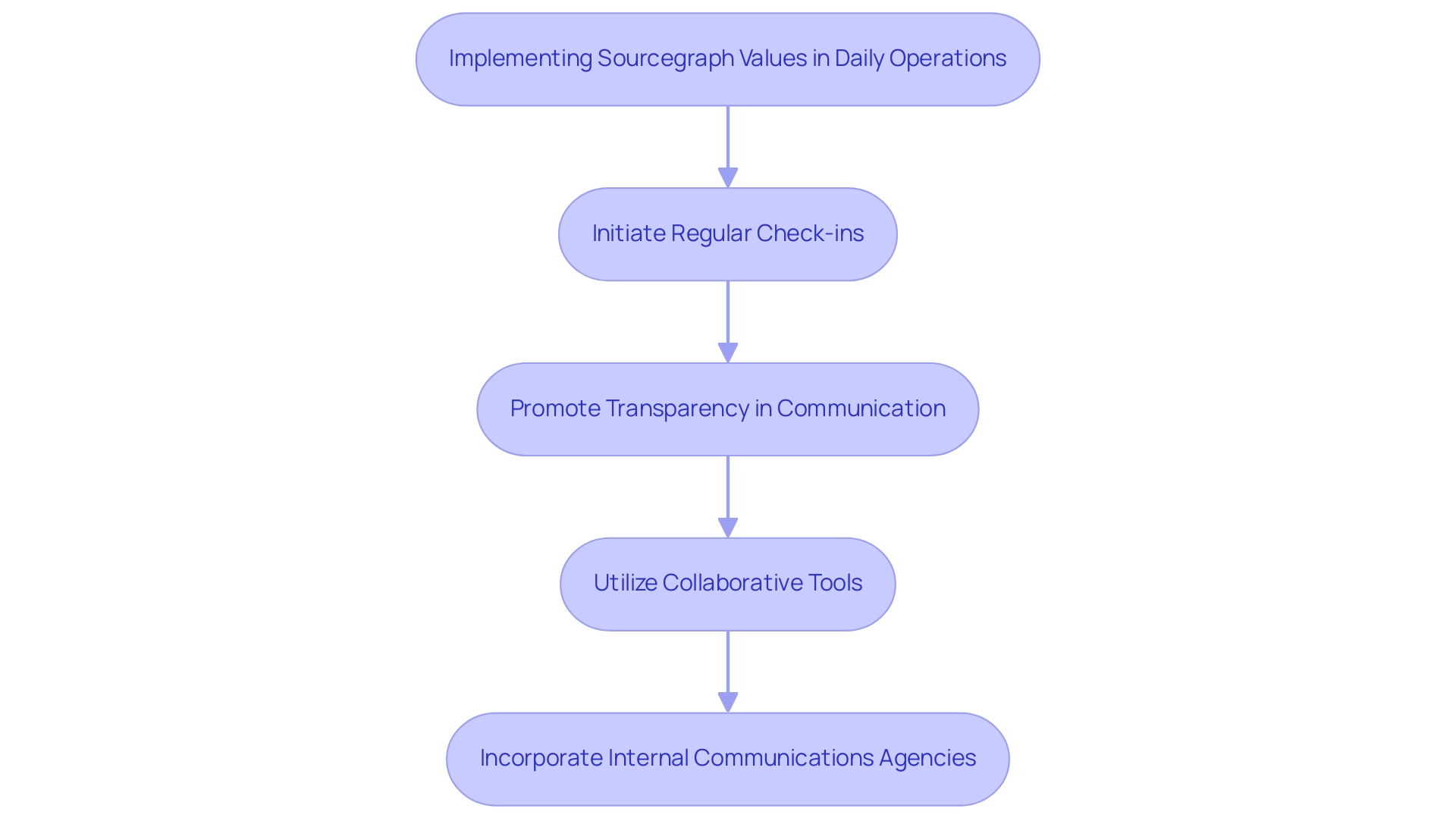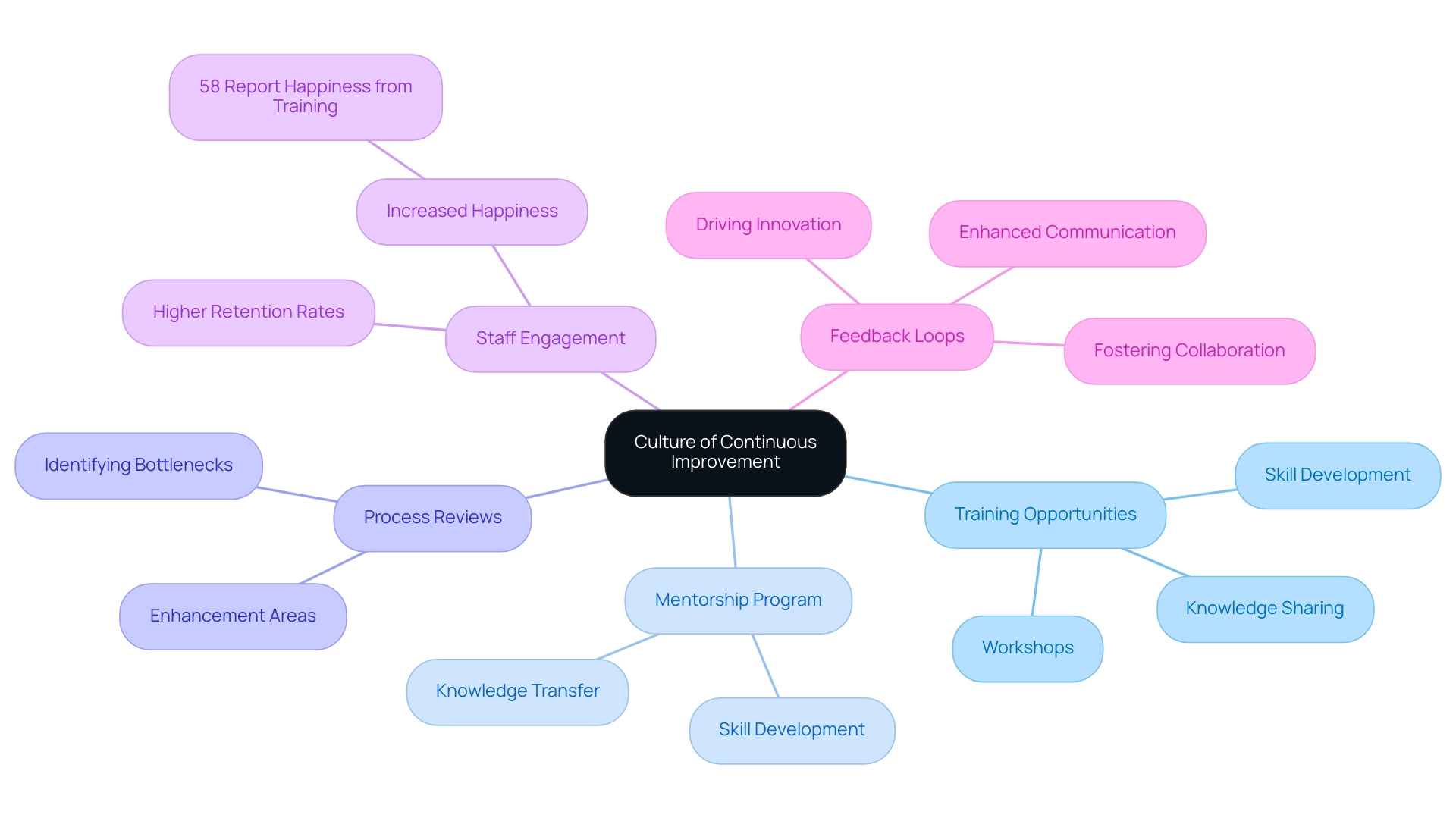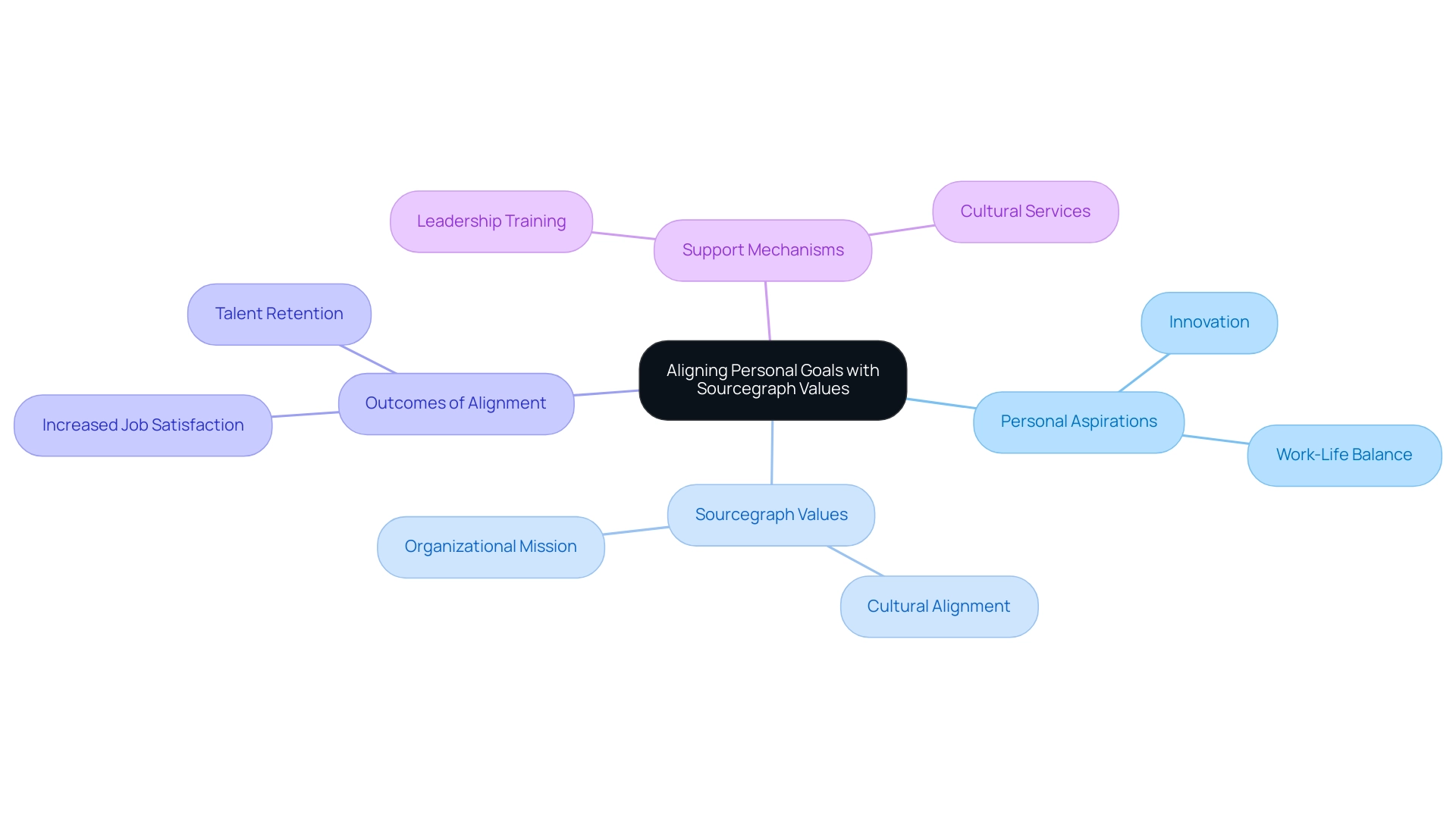Introduction
In the competitive landscape of modern workplaces, the values that organizations uphold can significantly influence employee engagement and productivity. Sourcegraph exemplifies this principle by embedding core values such as:
- Collaboration
- Transparency
- Innovation
into its culture. These guiding principles not only foster a sense of trust and belonging among employees but also enhance their ability to work effectively as a cohesive unit. As companies navigate the complexities of team dynamics and individual aspirations, the integration of these values becomes crucial for driving performance and maintaining a motivated workforce. By exploring how Sourcegraph operationalizes its core values, organizations can uncover strategies to cultivate a thriving environment that empowers employees and aligns personal goals with overarching business objectives.
Core Values of Sourcegraph: Guiding Principles for Employees
The organization's core values, known as sourcegraph values—collaboration, transparency, and innovation—serve as foundational pillars that empower employees to work cohesively and effectively. By prioritizing transparency, Sourcegraph fosters an environment of trust, which is crucial for open communication. This transparency streamlines interactions among team members, significantly improving problem-solving speed and productivity.
Research indicates that:
- 82% of leaders recognize time constraints as a significant obstacle to effective collaboration.
- 72% of staff recognize time constraints as a significant obstacle to effective collaboration.
This emphasizes the essential need for transparency in communication. A case study titled 'Challenges to Team Collaboration' reveals that:
- 64% of workers lose productivity due to poor collaboration.
This emphasizes the importance of addressing these barriers. When team members embrace these sourcegraph values in their daily responsibilities, they not only enhance their individual contributions but also align their efforts with Sourcegraph's strategic objectives.
As Jennifer Clark aptly states,
On the flip side, a group that leverages everyone’s strengths is equipped to seamlessly tackle complex challenges.
Furthermore, diversity and inclusion initiatives play a vital role in developing a sense of belonging and trust among staff, which supports a collaborative workplace culture. By integrating these core principles into their workplace culture, organizations can unlock substantial improvements in team performance and overall productivity.
The Role of Pay Transparency in Enhancing Employee Experience
At Sourcegraph, pay transparency is recognized as a vital component of the sourcegraph values regarding the staff experience. By openly disclosing salary ranges and compensation frameworks, the company cultivates an atmosphere of trust and equity. This proactive approach empowers staff to confidently negotiate their worth while reinforcing the organization’s dedication to the sourcegraph values of fairness and accountability.
When staff understand the logic behind compensation structures, they are more likely to feel that sourcegraph values their contributions, which significantly enhances their engagement and retention. Moreover, such transparency can enhance performance, as staff are made aware of the benchmarks that inform their pay. Notably, more than half of the workforce desires better job stability due to concerns about layoffs, making pay transparency even more relevant in addressing these fears.
As highlighted in the case study titled 'Practical Steps for Implementing Pay Transparency,' organizations are encouraged to adopt a phased approach to sharing pay information, which can lead to significant improvements in trust and satisfaction among staff. As Andrew Grissom aptly states,
Clearly, pay transparency and pay equity are not only critical for closing the gender pay gap; they are also proven strategies for transforming business and talent processes.
As organizations consider implementing similar strategies, particularly due to the need for enhanced staff retention in 2024, the positive impact on work experience and sourcegraph values becomes increasingly clear.
Implementing Sourcegraph Values in Daily Operations
To effectively incorporate sourcegraph values into daily operations, team members should initiate regular check-ins focused on openly discussing project progress and challenges. This practice not only promotes accountability but also establishes essential feedback loops that encourage collaboration and aligns with sourcegraph values by creating an environment where constructive criticism is valued. In fact, 49% of employees in the U.S. would leave a job if their employer’s principles did not align with their own, highlighting the critical need for alignment between company principles and employee practices.
Transparency in communication is essential; by sharing both successes and setbacks, groups can foster trust and mutual support, reflecting the sourcegraph values. As Etsy states, 'We lead with optimism: We believe in our mission, and we believe in each other,' reinforcing the message of collaboration and trust. Utilizing collaborative tools further improves awareness of ongoing projects, ensuring that all members stay aligned with the sourcegraph values and the company's core principles and objectives.
Moreover, internal communications agencies can play a crucial role in this process, as demonstrated by the case study on Experience Design, which illustrates how aligning principles with staff experiences can enhance morale and productivity. By embedding these practices into the workflow, organizations can cultivate a culture of collaboration that reflects sourcegraph values and drives both engagement and productivity.

Measuring the Impact of Sourcegraph Values on Team Performance
To effectively assess the influence of sourcegraph values on group performance, it is essential to establish specific, quantifiable objectives that focus on collaboration, transparency, and innovation. Regular staff sentiment surveys serve as a vital tool for assessing how well individual contributions align with these values; this is especially important when you consider that only 1 in 3 workers feel their performance is evaluated fairly. Furthermore, monitoring project completion rates and group engagement levels offers valuable insights into the integration of these principles into everyday workflows.
For instance, metrics such as the number of calls or emails handled can reveal productivity levels and responsiveness, which are crucial for maintaining high client satisfaction. This metric logs the volume of customer interactions a staff member manages over a certain period, particularly relevant in customer service roles, and provides insight into their productivity and responsiveness. By systematically examining performance data in conjunction with employee feedback, groups can identify areas requiring improvement and acknowledge accomplishments that demonstrate the organization's dedication to its fundamental principles.
This approach not only fosters a culture of continuous improvement but also reinforces the significance of sourcegraph values in driving the success of the team.
Promoting a Culture of Continuous Improvement
At Sourcegraph, fostering a culture of continuous improvement aligns with our sourcegraph values. This involves actively encouraging staff to pursue training opportunities, participate in workshops, and engage in knowledge-sharing with colleagues. A robust mentorship program is essential for skill development, creating an environment that prioritizes learning and growth.
Regularly reviewing processes and seeking input from team members allows for the identification of bottlenecks and areas for enhancement. Significantly, 58% of staff indicate that training enhances their happiness at work, highlighting the importance of such initiatives. As emphasized in the case study 'Aligning Training with Business Objectives,' aligning training programs with company goals ensures that individuals understand how their development contributes to overall success, fostering teamwork and enhancing organizational impact.
As Blair Epstein aptly puts it,
Indeed, one way to remain best-in-class is to maintain the striving ethic and constant tinkering that got the company there in the first place.
Embracing a mindset of continuous improvement not only drives innovation but also cultivates a more efficient workplace. Organizations that prioritize the sourcegraph values often see higher staff engagement and retention, as evidenced by reports that companies focused on continuous learning yield significant benefits for both personnel and overall business performance.
Furthermore, establishing feedback loops enhances communication and collaboration, which are critical for driving innovation and fostering a culture of continuous learning.

Aligning Personal Goals with Sourcegraph Values
Employees at Sourcegraph are encouraged to actively consider their personal aspirations and how these align with Sourcegraph values. This alignment not only fosters a deeper sense of purpose but also enhances overall job satisfaction. For instance, individuals who prioritize innovation may pursue projects that enable them to explore new technologies or methodologies, thereby contributing to the organization’s mission.
Regular self-assessment, coupled with open dialogue with managers, is crucial for maintaining this alignment as both personal and organizational goals evolve. Studies show that 55% of staff would contemplate leaving a new position if the organizational culture does not align with their personal principles. This statistic underscores the importance of cultural alignment in retaining talent.
Furthermore, a case study on generational differences reveals that 58% of younger workers would resign from a job that disrupts their work-life balance, indicating a strong preference for alignment with personal values. By ensuring that individual goals are in sync with the Sourcegraph values, employees can significantly boost their job satisfaction and productivity. Organizations like Culture Works offer services to help operationalize culture and improve processes, including leadership training that supports this alignment, ultimately creating a more cohesive and motivated workforce.

Conclusion
Embedding core values such as collaboration, transparency, and innovation into the workplace culture is essential for enhancing employee engagement and productivity. Sourcegraph exemplifies how these principles can create a cohesive environment where trust thrives, communication flourishes, and individual contributions align with organizational objectives. By prioritizing transparency and fostering open dialogue, companies can break down barriers that hinder collaboration and significantly improve problem-solving capabilities.
Moreover, the importance of aligning personal goals with company values cannot be overstated. When employees see their aspirations reflected in the organization’s mission, it cultivates a deeper sense of purpose and enhances job satisfaction. This alignment not only drives individual performance but also strengthens the overall team dynamic, leading to a more motivated workforce.
To fully realize the benefits of these core values, organizations must continuously measure their impact on performance and remain committed to fostering a culture of continuous improvement. By encouraging ongoing training and mentorship, companies can ensure that employees are equipped to adapt and thrive in an ever-evolving landscape. Ultimately, the integration of these principles into daily operations paves the way for sustained success, empowering employees and aligning their efforts with the broader goals of the organization.
Frequently Asked Questions
What are the core values of Sourcegraph?
The core values of Sourcegraph are collaboration, transparency, and innovation, which serve as foundational pillars for empowering employees to work cohesively and effectively.
How does transparency impact communication at Sourcegraph?
Transparency fosters an environment of trust, which is crucial for open communication. It streamlines interactions among team members, significantly improving problem-solving speed and productivity.
What obstacles to effective collaboration are recognized by Sourcegraph leaders and staff?
Research indicates that 82% of leaders and 72% of staff recognize time constraints as a significant obstacle to effective collaboration.
What are the consequences of poor collaboration according to the case study 'Challenges to Team Collaboration'?
The case study reveals that 64% of workers lose productivity due to poor collaboration, highlighting the importance of addressing these barriers.
How do Sourcegraph values influence individual contributions and strategic objectives?
When team members embrace Sourcegraph values in their daily responsibilities, they enhance their individual contributions and align their efforts with the organization’s strategic objectives.
What role do diversity and inclusion initiatives play at Sourcegraph?
Diversity and inclusion initiatives help develop a sense of belonging and trust among staff, supporting a collaborative workplace culture.
Why is pay transparency important at Sourcegraph?
Pay transparency is recognized as vital for fostering trust and equity among staff. By openly disclosing salary ranges and compensation frameworks, Sourcegraph empowers employees to negotiate their worth and reinforces fairness and accountability.
How does understanding compensation structures affect employee engagement at Sourcegraph?
When staff understand the logic behind compensation structures, they are more likely to feel valued, which significantly enhances their engagement and retention.
What challenges do employees face regarding job stability at Sourcegraph?
More than half of the workforce desires better job stability due to concerns about layoffs, making pay transparency relevant in addressing these fears.
What approach is recommended for implementing pay transparency in organizations?
The case study 'Practical Steps for Implementing Pay Transparency' recommends a phased approach to sharing pay information, which can lead to improvements in trust and satisfaction among staff.
How does pay transparency contribute to closing the gender pay gap?
Pay transparency and pay equity are critical strategies for closing the gender pay gap and transforming business and talent processes, as highlighted by Andrew Grissom.




